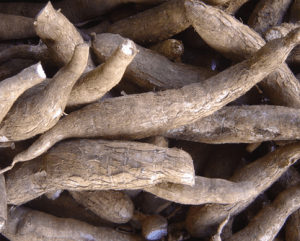Investors urged to take advantage of cassava
 Ghana produces about 16 million metric tonnes of cassava, of which 11 million tonnes is available for consumption.
Ghana produces about 16 million metric tonnes of cassava, of which 11 million tonnes is available for consumption.
Out of the figure only four million tonnes is being consumed leaving more than seven million tonnes as surplus.
This was made known by the Statistics, Research and Information Directorate of the Ministry of Food and Agriculture 2013-2014 report.
Over the last five years, there has been a steady growth in demand for commercial and industrial use of new cassava value added products including High Quality Cassava Flour (HQCF), Industrial Grade Cassava Flour, High Quality Cassava Chips, starch and Wet Cakes.
To attract new investors, provide access to market for investors (processors) and small-holder farmers, the Food Research Institute of the Council for Scientific and Industrial Research (FRI/CSIR) under the Cassava: Adding Value for Africa (C:AVA) Project has organised an investment forum in Accra to encourage industrialization and expansion in job creation in rural & semi-urban areas,
The forum which was on the theme “Cassava: A Versatile Crop for Economic Transformation and Industrial Growth”, sought to provide a holistic overview of the cassava value chain in Ghana, emphasising on the opportunities/prospect and the challenges.
It was also to look in particular at the improvement of livelihoods and incomes of at least 90,000 smallholder households as direct beneficiaries, including women and disadvantaged groups by helping them develop value chains for HQCF in Ghana, Tanzania, Uganda, Nigeria and Malawi.
Participants were taken through investment opportunities for potential chain actors, critical success factors, challenges, constraints and concerns, strategies to address challenges and increase investment, lessons learnt by CAVA Ghana and CAVA II Ghana’s Achievement
Mr Victor Agyemang, Director General of CSIR said the CAVA project would promote the use of HQCF as a versatile raw material for which diverse markets exist and called on investors to come on board to help make good use of the wastage in the system.
Alhaji Mohammed Bin Ibrahim, Member of the CSIR Governing Board called on stakeholders to come up with innovative ways of preserving cassava to maximise production and profit.
Cassava production and processing represent around 22 per cent of Ghana’s agricultural GDP.
Traditionally cassava is consumed in the form of fresh cassava roots and processed products.
Ghana is the sixth largest producer of cassava in the world with potential to produce much more. Majority of people employed in the agriculture sector in Ghana engage in cassava production or intercrop with cassava.
The sub-sector therefore contributes significantly to increasing income and livelihoods for men and women in the rural and semi-urban areas.
Present phenomena of industrialisation and commercialisation of the value chain, has created an additional opportunity for upstream and downstream chain actors to leverage for increased income and prosperity.
This is being driven by what could be termed as ‘the new industries for cassava prominence’, processing and drying technologies.
The demand for HQCF by the brewery/distillery industries as well as local use in bakery/pastries and in local dishes in the various cycles of education provides important opportunities for entrepreneurs to create wealth and employment.
Since the inception of the CAVA project, lessons learnt have indicated that inadequate processing capacity to mop up cassava produced by the farmers is a major constraint.
Consistent increase in demand for processed cassava products has put pressure on the current small number of processors whose production capacities are very low.
However, experience suggests that there is very significant number of potential investors scouting for reliable source of information on economic and industrial potential in the cassava value chain, hence the investment forum.
Source: GNA
